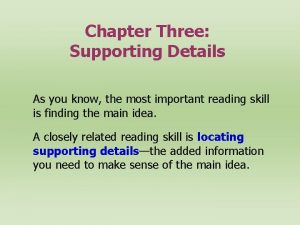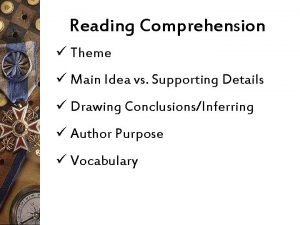Main Idea Supporting Details Day 1 I can










- Slides: 10

Main Idea & Supporting Details – Day 1 I can determine two or more main ideas of a text and explain how they are supported by key details; summarize the text. (RI 5. 2)

Review: What is the main idea of a passage?

Review: What is the main idea of a passage?

Review: What are supporting details in a passage?

Step #1 - Read the text What is the main idea of the passage? What supporting details prove your answer? Screech! When a driver pushes on the brake pedal, it initiates a process that causes the vehicle to stop in motion. We literally trust braking systems with our lives every time we get into a vehicle or cross at a busy intersection. How does this life-critical process work? It begins when the pedal is pushed. At this moment brake fluid is released into the braking mechanisms. As the fluid collects, this creates a leverage, which causes a friction to be applied. This friction will create a force that will cause the wheels to stop and allow you to reach your destination safely. Beep!

What is the main idea of the passage? What supporting details prove your answer? Step #2 – Ask yourself: What is the text mostly about? Screech! When a driver pushes on the brake pedal, it initiates a process that causes the vehicle to stop in motion. We literally trust braking systems with our lives every time we get into a vehicle or cross at a busy intersection. How does this life-critical process work? It begins when the pedal is pushed. At this moment brake fluid is released into the braking mechanisms. As the fluid collects, this creates a leverage, which causes a friction to be applied. This friction will create a force that will cause the wheels to stop and allow you to reach your destination safely. Beep!

What is the main idea of the passage? What supporting details prove your answer? Step #3 – Ask yourself: What supporting evidence proves your answer? Screech! When a driver pushes on the brake pedal, it initiates a process that causes the vehicle to stop in motion. We literally trust braking systems with our lives every time we get into a vehicle or cross at a busy intersection. How does this life-critical process work? It begins when the pedal is pushed. At this moment brake fluid is released into the braking mechanisms. As the fluid collects, this creates a leverage, which causes a friction to be applied. This friction will create a force that will cause the wheels to stop and allow you to reach your destination safely. Beep!

What is the main idea? What supporting details prove your answer? 1. Read the text 2. Ask yourself: what is the text mostly about? 3. Ask your: what supporting details prove your answer? “Not Just One Cent” A penny for your thoughts? If it’s a 1943 copper penny, it could be worth as much as fifty thousand dollars. In 1943, most pennies were made out of steel since copper was needed for World War II, so the 1943 copper penny is ultra-rare. Another rarity is the 1955 double die penny. These pennies were mistakenly double stamped, so they have overlapping dates and letters. If it’s uncirculated, it’d easily fetch $25, 000 at an auction. Now that’s a pretty penny.

What is the main idea? What supporting details prove your answer? 1. Read the text 2. Ask yourself: what is the text mostly about? 3. Ask your: what supporting details prove your answer? “The Truth About Halloween” Before you put on that skeleton costume and rove door-to-door pandering for candy, take a minute to reflect on this tradition. Halloween is believed to have come from an ancient Celtic festival dating back some 2, 000 years. November 1 st was the Celtic New Year and marked the end of summer to the Celts. They celebrated on its eve by wearing costumes made of animal skins and dancing around bon fires. Over the next two millennia, this primitive celebration grew to be the candy fueled costume ball that we know today.

What is the main idea? What supporting details prove your answer? 1. Read the text 2. Ask yourself: what is the text mostly about? 3. Ask your: what supporting details prove your answer? “Candy, Candy” It is estimated that over twenty million pounds of candy corn are sold in the US each year. Brach’s, the top manufacturer, sells enough candy corn to circle the earth 4. 25 times if each piece were laid end to end. That’s a lot of candy corn, but that’s nothing compared to the production of Tootsie Rolls. Over 64 million Tootsie Rolls are produced every day! But even Tootsie Rolls have got nothing on the candy industry’s staple product: chocolate. Confectioners manufacture over twenty billion pounds of chocolate in the United States each year. Now that’s a mouthful!
 Topic sentence
Topic sentence Tells more about the main idea
Tells more about the main idea Major supporting detail
Major supporting detail Paragraphs with main idea and supporting details
Paragraphs with main idea and supporting details Main idea and details jeopardy
Main idea and details jeopardy Three supporting details
Three supporting details Topics presented in chapters
Topics presented in chapters Minor and major details
Minor and major details Supporting detail
Supporting detail Whats supporting details
Whats supporting details Reading comprehension main idea and supporting details
Reading comprehension main idea and supporting details



















